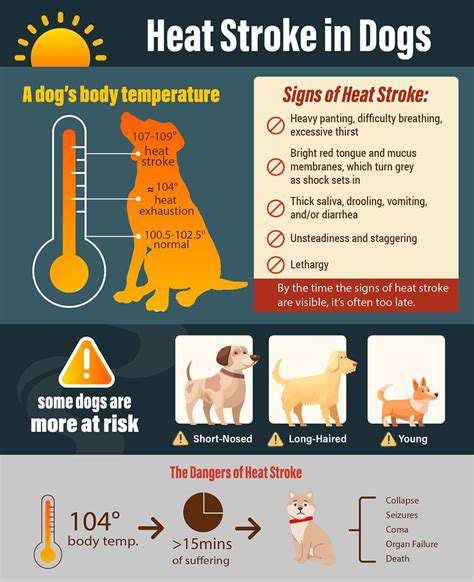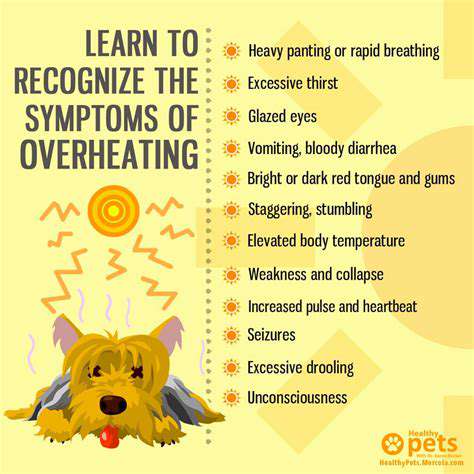Heat Hazards for Dogs: Preventing Heat Stress and Ensuring Their Safety
The Risks of Heat Exposure in Dogs

The Physiological Impact of Heat on Dogs
Dogs are particularly vulnerable to heat stress due to their unique physiological characteristics. Unlike humans, dogs do not have efficient cooling mechanisms such as sweating. Instead, they primarily rely on panting to regulate their body temperature.
When the temperature rises, a dog's body can begin to overheat, leading to serious health complications. Signs of overheating can include excessive panting, drooling, and lethargy. If not addressed quickly, this can progress to heatstroke, which is a medical emergency.
Understanding how heat affects a dog's body can help owners take proactive measures to prevent overheating. Providing access to cool water and shaded areas is essential, especially during the hottest parts of the day.
Prevention Strategies for Keeping Dogs Safe in the Heat
Preventing heat stress in dogs begins with awareness and preparation. It’s crucial for dog owners to recognize the early signs of overheating and have a plan in place for hot weather. Limiting outdoor activities during peak heat hours is an effective strategy to keep dogs safe.
Additionally, ensuring that dogs have access to fresh water at all times isn’t just a recommendation but a necessity. Hydration plays a critical role in regulating body temperature and preventing heat-related issues.
Owners should also consider investing in cooling products such as vests and mats to help maintain their dogs' core temperatures. By being proactive and attentive, dog owners can significantly reduce the risk of heat stress and ensure their pets enjoy a safe and comfortable summer.
Recognizing Symptoms of Heat Stress
Understanding the Signs of Heat Stress
Heat stress in dogs can manifest in a variety of ways. Owners should be vigilant in recognizing the early warning signs to prevent severe health issues. Common symptoms include excessive panting, drooling, and a change in behavior. If a dog seems lethargic or disinterested in activities they usually enjoy, this could be a red flag. Additionally, monitor for signs of distress such as whining or whining excessively.
Sometimes, dogs may exhibit physical symptoms like a racing heartbeat or an elevated body temperature. The normal body temperature for dogs ranges between 101°F and 102.5°F. A temperature exceeding 104°F may indicate heat stress and requires immediate attention. Always keep a thermometer handy for quick assessments during hot weather.
Gum color is another significant indicator of a dog’s health. Healthy gums are generally pink, but pale or blue gums may indicate a serious issue. If you notice any discoloration, it’s essential to act quickly and seek veterinary help. Look out for weakness or stumbling, especially after periods of heavy exercise in hot weather.
Behavioral changes might also signal heat stress. If a dog is suddenly resistant to going outside or refuses to play, this could indicate they are feeling overheated. Owners should take such changes in behavior seriously and evaluate their dog’s condition, especially during peak heat hours.
Lastly, keep an eye out for signs of confusion or disorientation. A dog experiencing heat-related complications may seem dazed or uncoordinated. This is a critical point where immediate interventions, such as moving the dog to a cooler environment, can help avoid more severe consequences.
Prevention Tips to Avoid Heat Stress
Preventing heat stress starts with understanding safe practices during hot weather. One of the most effective ways is to limit outdoor activities during peak heat hours, often between 10 AM and 4 PM. Scheduling walks and play sessions in the early morning or late evening can help reduce exposure to extreme temperatures.
Providing plenty of water is crucial for hydration. Always carry water when taking your dog out and encourage them to drink regularly. Keeping a water bowl filled in shaded areas is also beneficial, especially if you are spending time outside. Consider using a cooling mat or bandana to help them regulate their body temperature.
Dogs can also benefit from a designated shade area outside. If no natural shade is available, create shaded space using umbrellas, tarps, or other coverings. This allows your dog to escape direct sunlight and cool off whenever they need it. Avoid leaving dogs in vehicles, even for short periods, as temperatures can rise drastically within minutes.
Another preventive measure is to monitor your dog’s risk factors. Some breeds, particularly those with flat faces like Bulldogs and Pugs, are more susceptible to heat stress. Older dogs or those with pre-existing health conditions may also be at a greater risk. Understanding your dog's specific needs is vital for planning safe activities.
Lastly, encourage acclimatization during hot months. Gradually expose your dog to warmer temperatures over a few days to allow them to adapt. This can help reduce the chance of heat stress when they engage in outdoor activities. Regularly checking for any symptoms while participating in physical activity will ensure their safety and comfort.
Emergency Actions for Heat Stress
If you suspect your dog is suffering from heat stress, swift action is necessary. Remove the dog from the heat source immediately and find a cool, shaded area or air-conditioned space. Cooling them down is critical, and you can start by offering cool water, but ensure it isn’t ice-cold to avoid shock.
Applying cold, wet cloths to areas like the neck, groin, and paw pads can help lower the dog’s body temperature effectively. Avoid immersing them in cold water as this can cause the temperature to drop too rapidly, leading to hypothermia. Instead, aim for a gradual cooling process and continuously monitor their condition.
It’s also wise to keep an eye on your dog’s body temperature during this process. If it exceeds 104°F, it’s crucial to contact a veterinarian immediately. Professional medical assistance may be necessary if the dog shows severe signs of lethargy or confusion, even after initial cooling efforts.
When transporting your dog for veterinary care, ensure they are in a properly ventilated area of your vehicle. Use air conditioning, if available, to maintain a cool environment. Don’t hesitate to alert your vet about the situation on the way so they can prepare for your arrival.
Lastly, after the immediate emergency is handled, observe your dog for any lingering effects of heat stress. They may require a few days of rest and careful monitoring to ensure their health returns to normal. Stay informed and educated about heat stress to mitigate risks effectively in the future.
Prevention: Keeping Your Dog Safe in the Heat
Understanding Heat Stress in Dogs
Heat stress occurs when a dog's body temperature rises abnormally due to excessive heat. Dogs are particularly susceptible to heat stress because they do not sweat like humans. Instead, they release heat primarily through panting and limited sweating through their paw pads. During hot weather, these mechanisms can become ineffective, leading to dangerous conditions such as heat exhaustion or heatstroke.
Factors such as breed, age, weight, and overall health play significant roles in a dog's ability to cope with heat. Breeds with short snouts, like Bulldogs and Pugs, are at a higher risk as are older dogs and those with pre-existing health issues. It's crucial for dog owners to recognize the early signs of heat stress, which can include excessive panting, drooling, lethargy, and a rapid heartbeat.
Effective Strategies for Heat Safety
Keeping your dog safe during hot weather involves a multi-faceted approach. First and foremost, always provide access to fresh water and shaded areas to help them cool down when outdoors. You can also plan walks during cooler parts of the day, such as early morning or late evening, to avoid the hottest temperatures.
Another effective strategy is to create a cool environment at home, especially if your dog spends extended periods indoors. Consider using fans, air conditioning, or even cooling mats to help regulate their body temperature. Additionally, regular grooming can assist in maintaining their coat, as a clean and well-groomed dog can exude heat more efficiently.
Alternative Activities for Hot Days
Water Fun: Keeping Cool with Splashing
One of the best ways to keep dogs cool during hot weather is to engage them in water activities. This can include setting up a kiddie pool in your backyard where they can splash around and play. Dogs love the sensation of water, and it can provide much-needed relief from the heat.
If you have access to a safe swimming area, consider taking your dog for a swim. Always supervise them closely, as not all dogs are natural swimmers. You can also bring along floating toys to make the experience even more enjoyable for your furry friend.
Shaded Outdoor Play Zones
Creating shaded areas in your yard can provide a comfortable space for your dog to play outside without overheating. Use tarps, umbrellas, or even natural shade from trees to help block the sun. This way, your dog can enjoy the fresh air while staying cool and avoiding direct exposure to harmful UV rays.
You can set up toys and games in these shaded zones, like a gentle game of fetch or tug-of-war. Additionally, encouraging rest breaks in the shade is essential to help them regulate their body temperature during active play.
Indoor Enrichment: Games and Training
On especially hot days, indoor activities can provide great mental stimulation for your dog. Interactive toys and puzzles can keep them occupied and challenged while staying in a climate-controlled space. Consider investing in toys that dispense treats or require problem-solving for your dog to engage with.
Moreover, incorporating training sessions or obedience exercises can be an ideal way to bond and keep your dog engaged. Use positive reinforcement techniques to teach them new tricks or refine existing commands, allowing for both physical and mental exercise without risking their safety in the heat.
Structured Walks and Outings
While outdoor walks are essential for your dog's physical health, it's crucial to adjust the timing and intensity during hot days. Opt for early morning or late evening walks when temperatures are cooler. Shorter, more frequent outings can help prevent overheating and allow your dog to enjoy their exercise safely.
If your dog enjoys socializing, consider visiting pet-friendly indoor spaces, like dog cafes or shopping centers, that are air-conditioned. Bring plenty of water and take breaks to ensure your dog remains comfortable throughout the outing.
What to Do If Your Dog Shows Signs of Overheating

Recognizing the Signs of Overheating
When temperatures rise, it's crucial to monitor your dog for signs of overheating. Symptoms such as excessive panting, drooling, and lethargy can indicate that your dog is struggling with heat stress. Other signs may include a rapid heartbeat, vomiting, or difficulty breathing.
If you notice any of these symptoms, it's important to take action quickly to help your dog cool down before the situation worsens. Identifying these signs early can be the difference between a minor issue and a serious health crisis.
Immediate Steps to Take
As soon as you suspect your dog is overheating, move them to a cooler environment. Ideally, find a shaded area or an air-conditioned space where they can begin to cool down. You can also wet their fur with water, particularly around the neck, armpits, and groin, to help reduce their body temperature.
It's also a good idea to offer them cool, fresh water to drink. However, make sure not to give them ice-cold water, as this can cause shock. Instead, let them sip cool water slowly until they feel better.
- Exploring the Differences in Dog Coat Types: A Comprehensive Guide
- How to Identify Your Dog's Coat Length for Optimal Grooming
- Essential Grooming Schedule for Maintaining a Healthy Coat
- Daily care tips for maintaining your dog's coat
- The Importance of Preventing Overheating in Dogs
- Summer tips to keep your dog cool and comfortable